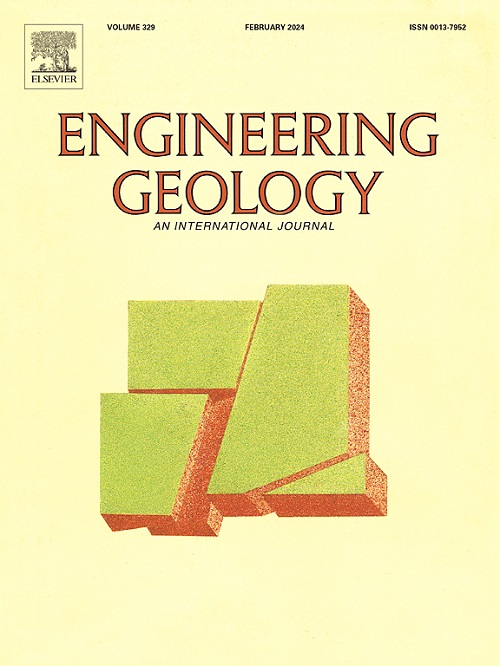Slip behaviors of rock joints subjected to weak shear disturbances: An experimental study
IF 6.9
1区 工程技术
Q1 ENGINEERING, GEOLOGICAL
引用次数: 0
Abstract
Frequent weak disturbances can induce dynamic shear slip along rock joints and potentially trigger dynamic hazards in rock masses. This study experimentally investigates the dynamic slip, failure, and instability behavior of jointed rocks under repeated shear disturbances. A custom dynamic shear testing apparatus was used to examine sawtooth-shaped rock joints subjected to weak shear disturbances, normal stress, and initial shear stress. The results reveal that the shear displacement of the joint progresses through three distinct stages: decelerated slip, constant-rate slip, and accelerated slip, forming an inverse S-shaped curve. Both the dynamic slip displacement caused by the disturbance and the post-disturbance deformation due to stress recovery in each cycle are captured. As disturbance cycles increase, a progressive instability process is identified, characterized by a transition from initial instability to stable damage accumulation, and finally to accelerated damage accumulation. Notably, all instabilities occurred during the stress recovery phase following the final disturbance. The effects of normal stress and joint undulation angle on these behaviors are also discussed. A combined linear-exponential model is proposed to quantify the shear slip in jointed rocks, incorporating a damage variable index. The p/a ratio in this model effectively describes the transition from stable to accelerated damage accumulation, which may also indicate the intensity of energy release. These findings provide guidance for the assessment of dynamic slip instability in jointed rock masses, particularly under far-field seismic events.
弱剪切扰动下岩石节理滑移行为的实验研究
频繁的弱扰动会引起岩石节理的动剪切滑移,并可能引发岩体的动力危害。实验研究了节理岩体在反复剪切扰动下的动态滑移、破坏和失稳行为。采用自定义动态剪切试验装置,对锯齿形岩石节理在弱剪切扰动、正应力和初始剪应力作用下进行了试验。结果表明:节理剪切位移经历减速滑移、匀速滑移和加速滑移三个阶段,形成倒s型曲线;在每个周期中,扰动引起的动态滑移位移和应力恢复引起的扰动后变形都被捕获。随着扰动周期的增加,识别出一个渐进的不稳定过程,其特征是从最初的不稳定到稳定的损伤积累,最后到加速的损伤积累。值得注意的是,所有不稳定都发生在最后扰动之后的应力恢复阶段。讨论了正应力和节理波动角对这些行为的影响。提出了一种结合损伤变量指标的线性-指数组合模型来量化节理岩体的剪切滑移。该模型中的p/a比有效地描述了从稳定到加速损伤积累的转变,也可以表明能量释放的强度。这些发现为节理岩体动态滑动失稳的评估提供了指导,特别是在远场地震事件下。
本文章由计算机程序翻译,如有差异,请以英文原文为准。
求助全文
约1分钟内获得全文
求助全文
来源期刊

Engineering Geology
地学-地球科学综合
CiteScore
13.70
自引率
12.20%
发文量
327
审稿时长
5.6 months
期刊介绍:
Engineering Geology, an international interdisciplinary journal, serves as a bridge between earth sciences and engineering, focusing on geological and geotechnical engineering. It welcomes studies with relevance to engineering, environmental concerns, and safety, catering to engineering geologists with backgrounds in geology or civil/mining engineering. Topics include applied geomorphology, structural geology, geophysics, geochemistry, environmental geology, hydrogeology, land use planning, natural hazards, remote sensing, soil and rock mechanics, and applied geotechnical engineering. The journal provides a platform for research at the intersection of geology and engineering disciplines.
 求助内容:
求助内容: 应助结果提醒方式:
应助结果提醒方式:


